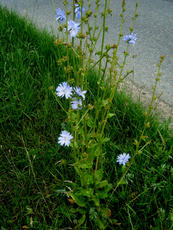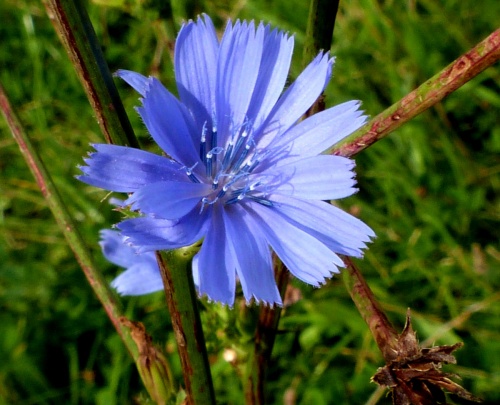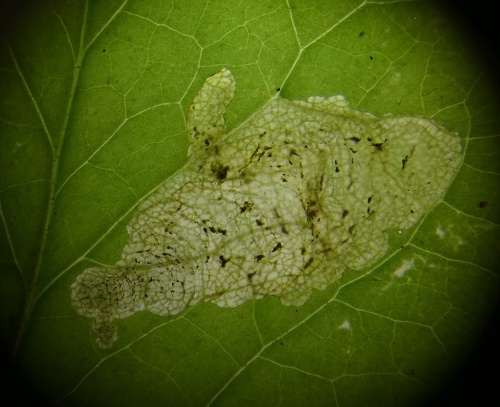Chicory - Cichorium intybus
Medium to tall plant. Stiffly hairy or hairless with latex, stems erect, branched. The basal leaves pinnately lobed to deeply toothed and short stalked. Upper leaves lanceolate untoothed or slightly toothed, clasping the stem. Flowerheads clear bright blue 25 to 40 mm in leafy branched spikes, all florets rayed, the rays strap like with a toothed tip.
Blue sow-thistle (Cicerbita macrophylla) has similar mauve-blue 'dandelion' flowers on a tall plant. Cicerbita macrophylla has an ovate apical lobe and often a pair of lateral lobes, flattened achenes and a pappus (the 'thistledown' attached to the seed).
Rough grassy habitats, roadside verges, wasteland and railway verges.
July to October
Perennial
Widespread but infrequent in Britain, particularly further north.
Not common in Leicestershire and Rutland. In The Flora of Leicestershire (Primavesi & Evans) it was found in 16 of the 617 tetrads.
It was on the 2011 VC55 Rare Plant Register (Jeeves, 2011) but is not on the current RPR (Hall & Woodward, 2022); it is listed as 'data deficient' because it is not clear whether records are of introduced/escaped plants or natives.
Leicestershire & Rutland Map
Enter a town or village to see local records
MAP KEY:
Yellow squares = NBN records (all known data)
Coloured circles = NatureSpot records: 2020+ | 2015-2019 | pre-2015
UK Map
Species profile
- Common names
- Chicory
- Species group:
- Wildflowers
- Kingdom:
- Plantae
- Order:
- Asterales
- Family:
- Asteraceae
- Records on NatureSpot:
- 95
- First record:
- 15/09/2010 (Calow, Graham)
- Last record:
- 23/08/2023 (Cunningham, Sally)
Total records by month
% of records within its species group
10km squares with records
The latest images and records displayed below include those awaiting verification checks so we cannot guarantee that every identification is correct. Once accepted, the record displays a green tick.
In the Latest Records section, click on the header to sort A-Z, and again to sort Z-A. Use the header boxes to filter the list.
Latest images
Latest records
Liriomyza puella
The larva of the Agromyzid fly Liriomyza puella mines the leaves of Nipplewort. The mine starts as a corridor which then expands into a blotch which is dark with white borders. The blotch mine is initially circular, or slightly elongated, but becomes irregular as the mine matures and turning brown with age.











